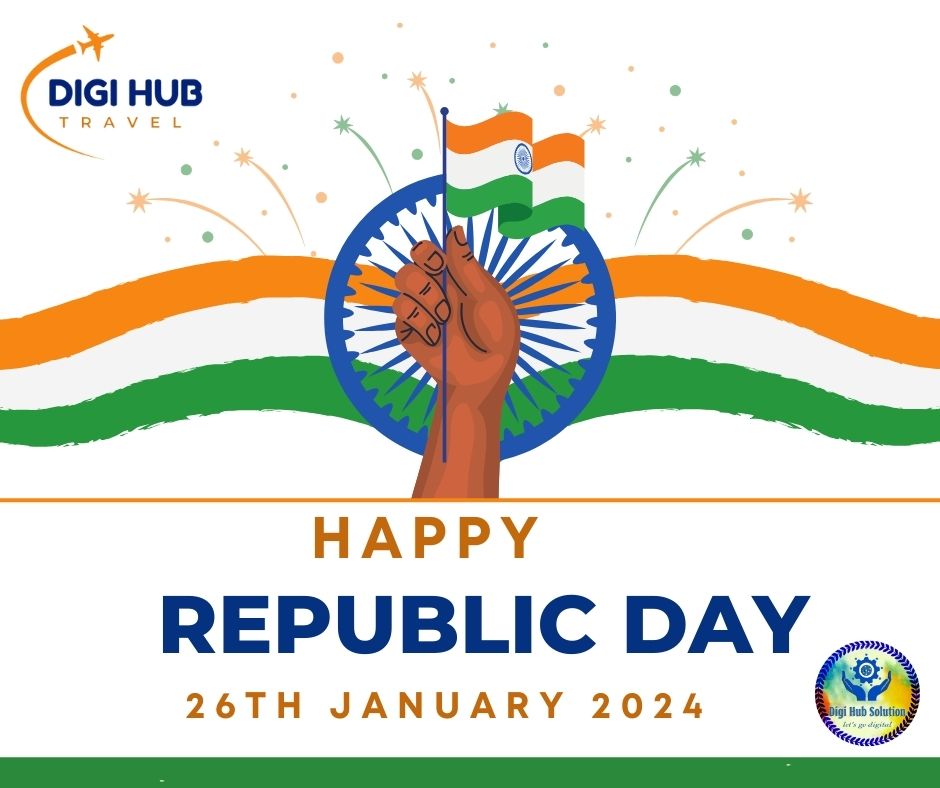Best wishes to all the countrymen on the 75th Republic Day.
As we all know, the Indian Constitution came into force on 26 January 1950 and since then we all celebrate this day as Republic Day. When our country got independence from the British rule on 15 August 1947, India did not have any constitution of its own, but later after much discussion, a committee was formed under the leadership of Dr. BR Ambedkar and the Indian Constitution was drafted. Draft prepared. This draft of the Indian Constitution was presented before the Legislative Council and adopted on 26 November 1949, but came into effect on 26 January 1950.

It was adopted by the Indian Constituent Assembly on 26 November 1949 and came into force on 26 January 1950 to become an independent republic and establish the rule of law in the country. The date of 26th January was chosen for its implementation because on this day in 1930, the Indian National Congress had declared India as Purna Swaraj.
Decorated and parades are taken out with great pomp on the parade route with tableaux of various states and government departments. People from every corner of the country come to Delhi to see the parade on 26 January. Weapons of the Indian Army were displayed. On 26 January, the President’s procession is taken out with great pomp and many interesting programs are organised.
On this day every Indian pays tribute to the immortal sons who sacrificed their lives for their country. The President addresses the nation on the eve of Republic Day. Many programs are organized in schools, colleges etc. The President of India hoists the Indian flag at the Rajpath in Delhi. Many attractive and fascinating programs are organized in the capital Delhi. Delhi is well decorated and parades are taken out with great pomp on
Flag hoisting takes place in every corner of the country and many types of programs are organized. People of Indian origin and Indian embassies across the world also celebrate Republic Day with enthusiasm. It is celebrated in every corner of India and a new enthusiasm towards the country is seen.
Purpose of celebrating Republic Day
The main purpose of celebrating Republic Day is that on 26 January 1950, the Constitution which was made after taking 2 years, 11 months and 18 days was implemented and our country India was declared a full republic.

On Republic Day, flag hoisting ceremonies and parades by armed forces and school children are held in different parts of the country. The grandest and most important of these parades is held at Kartavya Path in New Delhi, which showcases a multi-hued image of the country’s rich cultural heritage and military prowess.
History
In December 1929, the session of the Indian National Congress was held in Lahore under the chairmanship of Pandit Jawaharlal Nehru, in which a resolution was passed and it was announced that if the British Government does not grant the status of Dominion to India by 26 January 1930, then Under this, India became a self-governing unit within the British Empire. On that day, it announced the determination of complete independence of India and started its active movement. From that day until independence in 1947, 26 January was celebrated as Independence Day. After this, 15th August, the actual day of independence was accepted as the Independence Day of India. After India became independent, the Constituent Assembly was announced and it started its work from 9 December 1946. The members of the Constituent Assembly were elected by the elected members of the state assemblies of India. Dr. Bhimrao Ambedkar, Jawaharlal Nehru, Dr. Rajendra Prasad, Sardar Vallabhbhai Patel, Maulana Abul Kalam Azad etc. were the prominent members of this meeting. There were a total of 22 committees in the making of the Constitution, in which the Drafting Committee was the most prominent and important committee and the work of this committee was to ‘write’ or ‘construct’ the entire Constitution. The chairman of the drafting committee was jurist Dr. Bhimrao Ambedkar. The drafting committee and especially Dr. Ambedkar ji prepared the Indian Constitution in 2 years, 11 months, 18 days and handed over the Constitution of India to the President of the Constituent Assembly, Dr. Rajendra Prasad on 26 November 1949, hence on 26 November The day is celebrated every year as Constitution Day in India. The Constituent Assembly met for a total of 114 days at the time of drafting the Constitution. The press and the public had freedom to participate in its meetings. After several reforms and changes, 284 members of the Assembly signed two handwritten copies of the Constitution on 24 January 1950. Two days later, the Constitution came into force across the country on 26 January. To maintain the importance of 26 January, the republican form of India was recognized in the Constitution approved by the Constituent Assembly on this day. As you all know that on 15 August 1947, our country was freed from the slavery of the British (British rule) after the sacrifice of thousands of patriots. After this, Indian government and law and order came into force in our country on 26 January 1950.
Republic day celebration
On the Republic Day celebrations on 26 January, the Indian National Flag is hoisted by the President of India and after this the National Anthem is sung collectively.Then the tricolor national flag is saluted.Republic Day is celebrated with great enthusiasm all over the country especially in the capital of India, Delhi.To mark the significance of the occasion, every year a grand parade is held on the Rajpath from India Gate to Rashtrapati Bhavan (President’s residence) in the capital New Delhi.Various regiments of the Indian Army, Air Force, Navy etc. all participate in this grand parade.Children from National Cadet Corps and various schools come from all parts of the country to participate in this function, it is an honor to participate in the function.Starting the parade, the Prime Minister lays a wreath at the Amar Jawan Jyoti (a memorial to soldiers) located at the India Gate at one end of the Rajpath.After this, two minutes silence is observed in the memory of the martyred soldiers.It is a memorial to the sacrifices of the martyrs who sacrificed their lives for the country in the war fought to protect the sovereignty of the country and in the freedom movement.The Prime Minister then comes up to the dais on theRajpath along with other dignitaries, followed by the President with the chief guest of the occasion.
There are also exhibitions of different states in the parade, the specialties of the people of each state, their folk songs and art are presented in the exhibition.Every exhibition showcases the diversity and cultural richness of India.The parade and procession are broadcast on national television and watched by millions of viewers in every corner of the country.
Delhi Republic Day Parade
The Delhi Republic Day Parade is held in the capital New Delhi and is organized by the Ministry of Defence.Starting from Raisina Hill on the Rajpath behind India Gate, the entrance to Rashtrapati Bhavan (President’s residence), the event is a standout highlight of India’s Republic Day celebrations and lasts for three days.The parade showcases India’s defense capability, cultural and social heritage.Nine to twelve different regiments of the Indian Army, apart from the Navy and Air Force, march past with their bands in all their finery and official decorations.The President of India, who is the Commander-in-Chief of the Indian Armed Forces, takes the salute.Twelve contingents of various paramilitary forces and police forces of India also take part in this parade.
Beating Retreat Ceremony
The ceremony at the Vijay Chowk on January 29 every year marks the culmination of the four-day-long Republic Day celebrations. The Chief Guest of the function is the President of India who arrives in a cavalry unit escorted by the ‘President’s Bodyguards’ (PBG). When the President arrives, the PBG commander asks the unit to give the National Salute, which is followed by the playing of the Indian National Anthem, Jana Gana Mana, by the Massed Bands, and at the same time by the unfurling of the National Flag of India on the flagpole. Military Bands, Pipes and Drums Bands, Buglers and Trumpeters from various Army Regiments perform during the ceremony. Besides, there are bands from each of the Navy and Air Force. Most of the tunes being played by the Army’s Military Bands are based on Indian tunes.

‘Beating the Retreat’ has emerged as an event of national pride when the Colours and Standards are paraded. The ceremony traces its origin to the early 1950s when Major Roberts of the Indian Army indigenously developed the unique ceremony of display by the massed bands. ‘Beating Retreat’ marks a centuries old military tradition, when the troops ceased fighting, sheathed their arms and withdrew from the battlefield and returned to the camps at sunset at the sounding of the Retreat. Colours and Standards are cased and flags lowered. The ceremony creates longing for the times gone by.
The grandest celebrations take place in New Delhi with the flag hoisting ceremony followed by a parade, showcasing India’s rich cultural heritage and military prowess.
Award distribution
On the eve of Republic Day, the President of India distributes Padma Awards to the civilians of India every year. These are the second highest civilian awards in India after Bharat Ratna. These awards are given in three categories, viz. Padma Vibhushan, Padma Bhushan and Padma Shri, in decreasing order of importance.
Padma Vibhushan for “exceptional and distinguished service”. Padma Vibhushan is the second-highest civilian award in India.
Padma Bhushan for “distinguished service of a high order”. Padma Bhushan is the third-highest civilian award in India.
Padma Shri for “distinguished service”. Padma Shri is the fourth-highest civilian award in India.

While being national honours, the Padma awards do not include cash allowances, benefits, or special concessions in rail/air travel. Per a December 1995 judgment of the Supreme Court of India, no titles or honorifics are associated with the Bharat Ratna or any of the Padma awards; honorees cannot use them or their initials as suffixes, prefixes or pre- and post-nominals attached to the awardee’s name. This includes any such use on letterheads, invitation cards, posters, books etc. In the case of any misuse, the awardee will forfeit the award and cautioned against any such misuse upon receiving the honour.
The decoration comprises a sanad (Certificate) issued under the hand and seal of the President and a Medallion. The recipients are also given a replica of the medallion, which they can wear during any ceremonial/State functions etc., if they desire. A commemorative brochure giving out brief details in respect of each award winner is also released on the day of the investiture ceremony.


